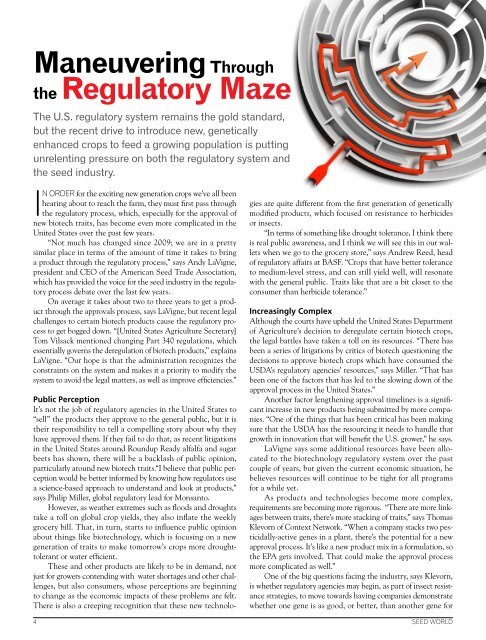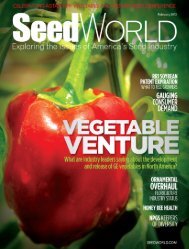Wet Chemistry Soybean Series - Seed World
Wet Chemistry Soybean Series - Seed World
Wet Chemistry Soybean Series - Seed World
- No tags were found...
You also want an ePaper? Increase the reach of your titles
YUMPU automatically turns print PDFs into web optimized ePapers that Google loves.
Maneuvering Throughthe Regulatory MazeThe U.S. regulatory system remains the gold standard,but the recent drive to introduce new, geneticallyenhanced crops to feed a growing population is puttingunrelenting pressure on both the regulatory system andthe seed industry.In order for the exciting new generation crops we’ve all beenhearing about to reach the farm, they must first pass throughthe regulatory process, which, especially for the approval ofnew biotech traits, has become even more complicated in theUnited States over the past few years.“Not much has changed since 2009; we are in a prettysimilar place in terms of the amount of time it takes to bringa product through the regulatory process,” says Andy LaVigne,president and CEO of the American <strong>Seed</strong> Trade Association,which has provided the voice for the seed industry in the regulatoryprocess debate over the last few years.On average it takes about two to three years to get a productthrough the approvals process, says LaVigne, but recent legalchallenges to certain biotech products cause the regulatory processto get bogged down. “[United States Agriculture Secretary]Tom Vilsack mentioned changing Part 340 regulations, whichessentially governs the deregulation of biotech products,” explainsLaVigne. “Our hope is that the administration recognizes theconstraints on the system and makes it a priority to modify thesystem to avoid the legal matters, as well as improve efficiencies.”Public PerceptionIt’s not the job of regulatory agencies in the United States to“sell” the products they approve to the general public, but it istheir responsibility to tell a compelling story about why theyhave approved them. If they fail to do that, as recent litigationsin the United States around Roundup Ready alfalfa and sugarbeets has shown, there will be a backlash of public opinion,particularly around new biotech traits.“I believe that public perceptionwould be better informed by knowing how regulators usea science-based approach to understand and look at products,”says Philip Miller, global regulatory lead for Monsanto.However, as weather extremes such as floods and droughtstake a toll on global crop yields, they also inflate the weeklygrocery bill. That, in turn, starts to influence public opinionabout things like biotechnology, which is focusing on a newgeneration of traits to make tomorrow’s crops more droughttolerantor water efficient.These and other products are likely to be in demand, notjust for growers contending with water shortages and other challenges,but also consumers, whose perceptions are beginningto change as the economic impacts of these problems are felt.There is also a creeping recognition that these new technolo-gies are quite different from the first generation of geneticallymodified products, which focused on resistance to herbicidesor insects.“In terms of something like drought tolerance, I think thereis real public awareness, and I think we will see this in our walletswhen we go to the grocery store,” says Andrew Reed, headof regulatory affairs at BASF. “Crops that have better toleranceto medium-level stress, and can still yield well, will resonatewith the general public. Traits like that are a bit closer to theconsumer than herbicide tolerance.”Increasingly ComplexAlthough the courts have upheld the United States Departmentof Agriculture’s decision to deregulate certain biotech crops,the legal battles have taken a toll on its resources. “There hasbeen a series of litigations by critics of biotech questioning thedecisions to approve biotech crops which have consumed theUSDA’s regulatory agencies’ resources,” says Miller. “That hasbeen one of the factors that has led to the slowing down of theapproval process in the United States.”Another factor lengthening approval timelines is a significantincrease in new products being submitted by more companies.“One of the things that has been critical has been makingsure that the USDA has the resourcing it needs to handle thatgrowth in innovation that will benefit the U.S. grower,” he says.LaVigne says some additional resources have been allocatedto the biotechnology regulatory system over the pastcouple of years, but given the current economic situation, hebelieves resources will continue to be tight for all programsfor a while yet.As products and technologies become more complex,requirements are becoming more rigorous. “There are more linkagesbetween traits, there’s more stacking of traits,” says ThomasKlevorn of Context Network. “When a company stacks two pesticidally-activegenes in a plant, there’s the potential for a newapproval process. It’s like a new product mix in a formulation, sothe EPA gets involved. That could make the approval processmore complicated as well.”One of the big questions facing the industry, says Klevorn,is whether regulatory agencies may begin, as part of insect resistancestrategies, to move towards having companies demonstratewhether one gene is as good, or better, than another gene for4 <strong>Seed</strong> <strong>World</strong>






